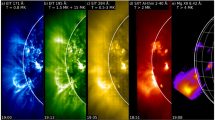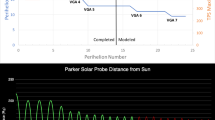Abstract
We present spectra and broad-band polarized light data from a novel suite of instruments deployed during the 21st August 2017 total solar eclipse. Our goals were to survey solar spectra at thermal infrared wavelengths during eclipse, and to test new technology for measuring polarized coronal light. An infrared coronal imaging spectrometer, flown at 14.3 km altitude above Kentucky, was supported on the ground by observations from Madras, Oregon (elevation 683 m) and Camp Wyoba on Casper Mountain, Wyoming (2402 m). In Wyoming we deployed a new infrared Fourier Transform Spectrometer (FTS), three low-dispersion spectrometers loaned to us by Avantes, a novel visible-light camera PolarCam, sensitive to linear polarization, and one of two infrared cameras from FLIR Systems, the other operated at Madras. Circumstances of eclipse demanded that the observations spanned 17:19 to 18:26 UT. We analyze spectra of the limb photosphere, the chromosphere, prominences, and coronal lines from 310 nm to 5.5 μm. We calibrated data photometrically using the solar disk as a source. Between different spectrometers, the calibrations were consistent to better than 13%. But the sensitivities achieved were insufficient to detect coronal lines from the ground. The PolarCam data are in remarkable agreement with polarization data from the K-Cor synoptic instrument on Mauna Loa, and with FLIR intensity data acquired in Madras. We discuss new results, including a detection of the He i 1083 nm multiplet in emission during the whole of totality. The combination of the FTS and AIR-Spec spectra reveals for the first time the effects of the telluric extinction on the infrared coronal emission lines, to be observed with upcoming Daniel K. Inouye Solar Telescope.














Similar content being viewed by others
References
Allen, C.W.: 1973, Astrophysical quantities, Athlone Press, London.
Ayres, T.R., Rabin, D.: 1996, Astrophys. J.460, 1042. DOI .
Billings, D.E.: 1966, A guide to the solar corona, Academic Press, New York.
Casini, R., White, S.M., Judge, P.G.: 2017, Space Sci. Rev.210, 145. DOI .
Coffey, M.T., Hannigan, J.W., Goldman, A.: 2006, J. Geophys. Res., Atmos. 111. DOI .
De Mazière, M., Thompson, A.M., Kurylo, M.J., Wild, J.D., Bernhard, G., Blumenstock, T., et al.: 2018, Atmos. Chem. Phys.18, 4935. DOI .
de Pontieu, B., McIntosh, S., Hansteen, V.H., et al.: 2007, Publ. Astron. Soc. Japan59, 655. DOI .
Del Zanna, G., DeLuca, E.E.: 2018, Astrophys. J.852, 52. DOI .
Eddy, J.A.: 2009, The Sun, the Earth and Near-Earth Space: A Guide to the Sun-Earth System (NASA).
Golub, L., Pasachoff, J.M.: 2009, The Solar Corona, 2nd edn. Cambridge University Press, Cambridge.
Grotrian, W.: 1933, Z. Astrophys.7, 26.
Habbal, S.R., Ding, A., Druckmuller, M., Solar Wind Sherpas: 2018, In: Observations of the Dynamics and Thermodynamics of the Corona during the 21 August 2017 Total Solar Eclipse, American Astronomical Society Meeting Abstracts231, 220.07.
Hase, F., Wallace, L., McLeod, S.D., Harrison, J.J., Bernath, P.F.: 2010, J. Quant. Spectrosc. Radiat. Transf.111, 521.
Hoyle, F.: 1955, Frontiers of Astronomy, Heinemann Educational Books, London.
Judge, P., Casini, R., Tomczyk, S., Edwards, D.P., Francis, E.: 2001, Coronal Magnetogmetry: A feasibility study. Tech. Rep. NCAR/TN-446-STR, National Center for Atmospheric Research.
Judge, P.G.: 1998, Astrophys. J.500, 1009. DOI .
Judge, P.G., Carlsson, M.: 2010, Astrophys. J.719, 469. DOI .
Judge, P.G., Reardon, K., Cauzzi, G.: 2012, Astrophys. J.755, L11. DOI .
Judge, P.G., Tomczyk, S., Hannigan, J., Sewell, S.: 2019, Astrophys. J.877, 10. DOI .
Judge, P.G., Tomczyk, S., Livingston, W.C., Keller, C.U., Penn, M.J.: 2002, Astrophys. J.576, L157. DOI .
Judge, P.G., Tritschler, A., Low, B.C.: 2011, Astrophys. J.730, L4. DOI .
Kuhn, J.R., Penn, M.J., Mann, I.: 1996, Astrophys. J.456, L67. DOI .
Lin, H., Penn, M.J., Tomczyk, S.: 2000, Astrophys. J.541, L83. DOI .
Lipartito, I., Judge, P.G., Reardon, K., Cauzzi, G.: 2014, Astrophys. J.785, 109. DOI .
Moise, E., Raymond, J., Kuhn, J.R.: 2010, Astrophys. J.722, 1411. DOI .
Münch, G., Neugebauer, G., McCammon, D.: 1967, Astrophys. J.149, 681. DOI .
Penn, M.J., Arnaud, J., Mickey, D.L., Labonte, B.J.: 1994, Astrophys. J.436, 368. DOI .
Penn, M.J., Kuhn, J.R.: 1994, ApJ434, 807. DOI .
Penn, M.J., Kuhn, J.R.: 1994b, Solar Phys.151, 511. DOI .
Penn, M.J., Lin, H., Tomczyk, S., Elmore, D., Judge, P.G.: 2004, Solar Phys.222, 61. DOI .
Sakurai, T.: 2017, Proc. Japan Acad. Ser. B93, 87. DOI .
Samra, J.E.: 2018, PhD thesis, Harvard University.
Samra, J.E., Judge, P.G., DeLuca, E.E., Hannigan, J.W.: 2018, Astrophys. J.856, L29. DOI .
Samra, J.E., Judge, P.G., DeLuca, E.E., Hannigan, J.W.: 2019, Astrophys. J. Lett.873, L25. DOI .
York, T., Powell, S.B., Gao, S., et al.: 2014, Proc. IEEE102, 1450. DOI .
Zaitsev, V.V., Shibasaki, K.: 2005, Astron. Rep.49, 1009. DOI .
Acknowledgements
We gratefully acknowledge HAO director Scott McIntosh and NASA-ISE (P. Bryans PI) supported the NAI experiment; Vanda Grubisic and her team at the EOL-NCAR laboratory for support during planning, proposing for and flying the G V aircraft; the NSF MRI program and the Smithsonian Institution for supporting the AIR-Spec project through grant AGS-1531549; NASA-ISE for support of the ROSETTA STONE proposal (P. Judge and S. Tomczyk PIs) funding the ground-based FLIR and PolarCam instruments; FLIR for the generous loan of their infrared camera; Avantes corporation for the generous loan of three spectrometers between 0.31 and 2.5 microns; NSF’s REU program for support of A. Boll, K. Gibson and A. Vira. We thank the people at Camp Wyoba for their generous hospitality, enthusiasm and kindness.
Author information
Authors and Affiliations
Corresponding author
Ethics declarations
Disclosure of Potential Conflicts of Interest
The authors declare that they have no conflicts of interest.
Additional information
Publisher’s Note
Springer Nature remains neutral with regard to jurisdictional claims in published maps and institutional affiliations.
Rights and permissions
About this article
Cite this article
Judge, P., Berkey, B., Boll, A. et al. Solar Eclipse Observations from the Ground and Air from 0.31 to 5.5 Microns. Sol Phys 294, 166 (2019). https://doi.org/10.1007/s11207-019-1550-3
Received:
Accepted:
Published:
DOI: https://doi.org/10.1007/s11207-019-1550-3




